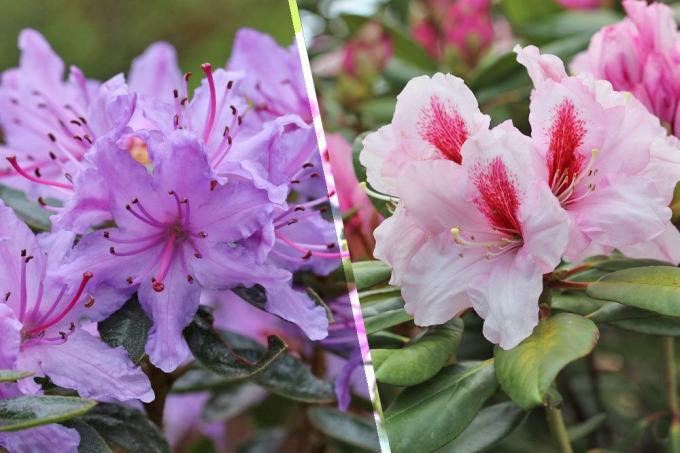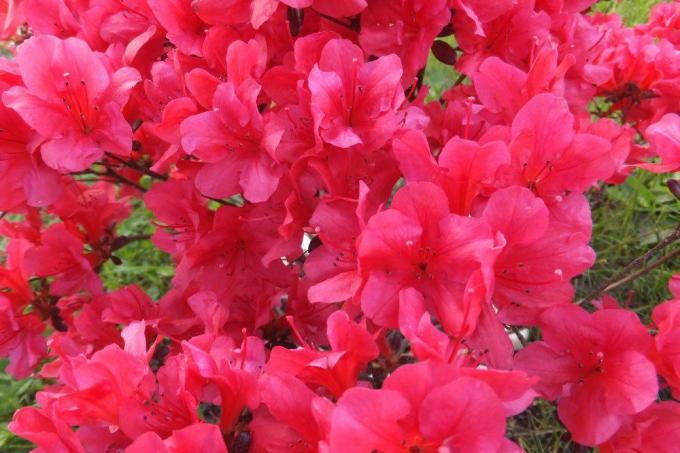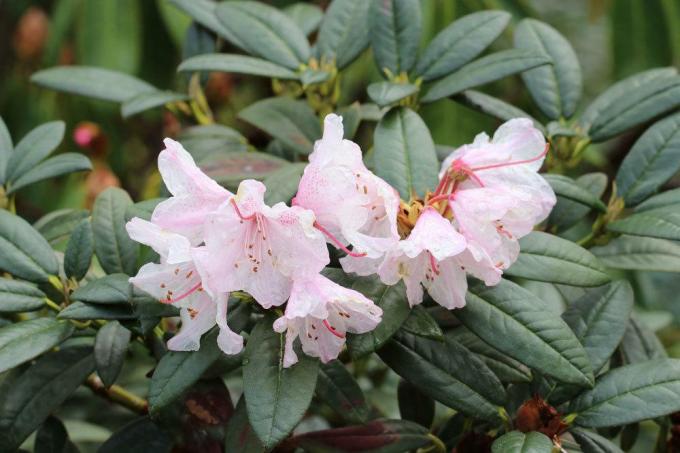
table of contents
- Rhododendron varieties
- New hybrids
- Varieties from A - D
- Varieties from G - M
- Ancient species
- Varieties from B - K
- Varieties from P - U
- Rare varieties
- Varieties from G - K
- Varieties from L - R
The genus rhododendron belongs to the heather family, which have the botanical name Ericaceae. There are countless species worldwide that are still divided into different types. The geographical distribution of these plants is just as diverse. In the gardens of the local latitudes, rhododendrons have become popular because of the wide range of colors of the flowers, which is the result of constant cultivations. In addition to the breathtaking display of flowers, the distinctive foliage, good winter hardiness and compact growth are important.
Rhododendron varieties
New hybrids
Most of the varieties from the specialist trade are hybrids, which have emerged from old species over the course of time through crossings and breeding. The aim of breeding rhododendrons is to inherit beneficial properties that are valued by gardeners. This includes sufficient frost resistance for the local winters, dense growth and lush inflorescences. Many of the culture forms common today come from Southeast Asia. Due to their origin, these varieties prefer moist and highly humic soil with slightly acidic conditions. Furthermore, most rhododendrons thrive better in partially shaded to shady light conditions.

Varieties from A - D
Aureolin
The attractive hybrid Aureolin is new on the market and has quite small flowers that change color over the course of the flowering period. However, the colorful spectacle can only be admired for a relatively short time. On the other hand, the strongly growing foliage remains well beyond the flowering period and is extremely hardy. The plant only reaches its full height after ten years.
- The flower color changes from carmine red to light yellow
- The flowering period is from mid-May to early June
- Dark green and frost hardy foliage
- Grows broad and rounded
- Grows up to 1.3 m high and 1.8 m wide
Cherry Kiss
The hybrid Cherry Kiss has extremely large flowers for a rhododendron and enchants with its strong flower color. The very light and cream-colored anthers, which stand out strongly against the dark flower color, are very noticeable. The foliage grows thick and shiny. Cherry Kiss only reaches its full height after ten years.
- Dark red and bright flowers
- Medium to dark green foliage with frost-hardy properties
- Flowering begins in mid-May and continues until early June
- Broad and upright growth
- Grows up to 1.20 m high and 1.50 m wide
Diana
The hybrid Diana convinces with bright flowers, the color of which becomes steadily stronger from the center to the edge. What is new is a fine, rust-red speckle, which can be seen on the upper petals in the interior. If the weather is favorable, the flowering period lasts about a month. The plant grows moderately and forms a closed crown. This rhododendron reaches its full height within ten years.
- Forms salmon pink flowers
- Flowering begins at the end of May and continues until the end of June
- Medium green leaves with a slight curvature
- The plant is sufficiently hardy
- Stems are colored reddish
- Crown is broad and spherical
- Becomes about four feet high and five feet wide
Varieties from G - M

Golden Everest
This strain changes color from the time the buds form until the flowers open. This differently colored border gradually disappears as it blooms, while the actual bloom shines in color for a longer period of time. In favorable weather conditions, this rhododendron can bloom for almost a month. The foliage has a satin gloss and forms an attractive frame for the flowers. Golden Everest is one of the rather weak-growing Varieties and only reaches its full height after many years. Therefore, it is well suited for gardens with limited space.
- Forms orange-red buds
- Then these develop into golden yellow inflorescences
- The flowers are surrounded by a reddish border
- The flowering period lasts from late May to late June
- Medium green foliage with good winter hardiness
- Grows wide and upright
- Height about 80 cm and width about 90 cm
Julia
The flowering time of the Julia variety does not last very long. However, the developed flower pile looks particularly lush, as the petals are laid out in double rows. For this purpose, the edges of the leaves are slightly rolled up. This rhododendron grows relatively weak and remains stocky even with age.
- Flowering time from mid-May to early June
- Makes pink-rose to salmon-orange flowers
- Foliage is dark green and shiny
- Round and compact growth
- Becomes about 90 cm high and 100 cm wide
Metallica
The Metallica variety enchants with extremely voluminous inflorescences, which are composed of many individual flowers. The striking foliage forms a very nice contrast to the intense flower color, which is a striking splash of color in the garden. This hybrid grows very strong and upright, which is why it is also suitable for creating hedges.
- Flowering period from late May to late June
- Inflorescence is made up of 14 to 21 individual flowers
- Flowers are light purple with large and dark purple eyes
- Dark green foliage with good winter hardiness
- Maximum height about 1.40 m and width 1.60 m
Ancient species
Various types of rhododendrons have been cultivated in Germany and Europe for several centuries. Due to their natural occurrence in the local latitudes, these are well adapted to the local conditions and are therefore extremely hardy. Both small and large-flowered options are available.
Varieties from B - K
Lashed alpine rose
The lashed alpine rose is also very old and originated in 1753. Their heyday begins relatively late for rhododendrons.
- Flowering period from June to July
- The flower color is pale pink, rarely white
- Shrub-like habit
- Grows up to 1.00 m
- Extremely hardy
Caucasus
The species Caucasus is particularly old and dates from 1788. This rhododendron impresses with its light flower color and compact growth.
- Flowering time from April to May
- Creamy white to yellow flowers, rarely pale pink
- Shrub-like habit
- Grows from 30 cm to 100 cm
- Extremely hardy
Varieties from P - U
Pontic rhododendron
This type of rhododendron is also very old and dates back to 1762. The plant can reach enormous proportions, which must be taken into account when choosing the right location. There are beautiful variations in the flower colors that shine strongly.
- Flowering time from May to June
- Flower color can be either pale pink, purple, or purple
- Shrub to tree-like habit
- Can grow up to 8 m
- Extremely hardy
Simonkai
This species became known from 1851 and grows rather weakly. This is why Simonkai is well suited for manageable gardens.
- Flowering time in May
- The flower color is pink
- Shrub-like habit
- Grows up to 60 cm high
- Extremely hardy
Reluctant rhododendron
This rhododendron species dates back to 1885 and can reach tree-like dimensions. Therefore, it needs a lot of space in its location in the garden. However, both the site and weather conditions must be right for strong growth.
- Flowering period from June to July
- White flower color that overflows into pink
- Shrub to tree-like habit
- Can grow up to 7 m
- Extremely hardy
Rare varieties
Some of the rhododendron varieties are quite rare in this country because they come from foreign countries. Some of them are not or only partially winter hardy and therefore only suitable for indoor culture. However, some of the varieties continued to be bred for decades and in this way have been made suitable for the local conditions of the local regions. These include above all Yakushimanum varieties, which grow in Japan at extreme altitudes. Thanks to a felt hair on the young shoots, which serves as protection from the sun and cold, these varieties can withstand both strong sunlight and low temperatures.
Varieties from G - K
Gold topaz
The gold topaz is one of the deciduous rhododendrons that shed their leaves in autumn after they had previously turned brightly colored. In this way, the variety offers variety in the garden landscape over the course of the year. The developed inflorescences are rich and colorful. Gold topaz prefers sunny to partially shaded locations in the garden.
- Flowering period from late May to late June
- Bright yellow and trumpet-shaped single flowers
- Rather elongated leaves, glossy and dark green
- Upright and broad growth
- Grows up to 1.50 m high and 1 m wide
Kalinka
Due to its home on sunny mountain slopes, this variety adapts perfectly to the prevailing conditions in Europe. This rhododendron also serves as a planting for graves and beautifies every rock garden. Unlike most hybrids, this variety prefers sunny to partially shaded locations.
- The flowering period begins in mid-May
- Flowers are deep pink and slightly darker at the edge
- Slightly shiny and dark green foliage
- Round and compact habit
- Maximum size about 1.20 m and width 1.60 m
Varieties from L - R
Luisella
The Luisella variety belongs to the group of dwarf rhododendrons, which score points with their compact growth and small flowers. Therefore this is ideal for the Bucket keeping on the balcony and terrace. In addition, Luisella is a beautiful ornament for the house entrance, rock garden, Japanese garden and also serves as a grave plant. In these locations, the variety prefers sunny to partially shaded conditions.
- Flowering time from mid to late May
- Makes purple-blue and trumpet-shaped single flowers
- Leaves are small and elongated with a gray-green color
- Grows slowly and stockily
- Only about 40 cm high and wide
Red Jack
Red Jack is one of the large-flowered rhododendrons and can reach tree-like heights. Many individual flowers grow on the inflorescences and give them voluminous proportions. Therefore, this variety needs a lot of space in the garden, with sunny to partially shaded conditions.
- Flowering time from the beginning of May to the beginning of June
- Forms red single flowers
- Dark green leaves with hardy properties
- Upright and bushy growth, strong in width
- Can reach heights of up to 2 m



